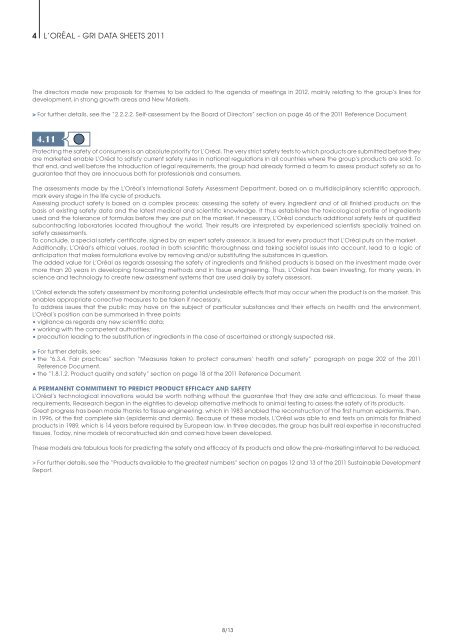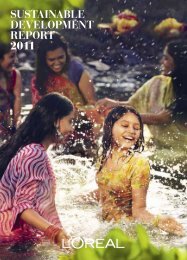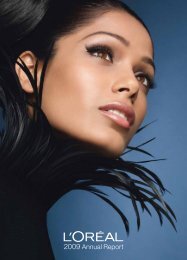Organizational Strategy - Sustainable Development - L'Oréal
Organizational Strategy - Sustainable Development - L'Oréal
Organizational Strategy - Sustainable Development - L'Oréal
You also want an ePaper? Increase the reach of your titles
YUMPU automatically turns print PDFs into web optimized ePapers that Google loves.
4 L’OréaL - GrI DaTa SHEETS 2011<br />
The directors made new proposals for themes to be added to the agenda of meetings in 2012, mainly relating to the group’s lines for<br />
development, in strong growth areas and New Markets.<br />
> For further details, see the “2.2.2.2. Self-assessment by the Board of Directors” section on page 46 of the 2011 reference Document.<br />
4.11<br />
Protecting the safety of consumers is an absolute priority for L’Oréal. The very strict safety tests to which products are submitted before they<br />
are marketed enable L’Oréal to satisfy current safety rules in national regulations in all countries where the group’s products are sold. To<br />
that end, and well before the introduction of legal requirements, the group had already formed a team to assess product safety so as to<br />
guarantee that they are innocuous both for professionals and consumers.<br />
The assessments made by the L’Oréal’s International Safety assessment Department, based on a multidisciplinary scientific approach,<br />
mark every stage in the life cycle of products.<br />
assessing product safety is based on a complex process: assessing the safety of every ingredient and of all finished products on the<br />
basis of existing safety data and the latest medical and scientific knowledge. It thus establishes the toxicological profile of ingredients<br />
used and the tolerance of formulas before they are put on the market. If necessary, L’Oréal conducts additional safety tests at qualified<br />
subcontracting laboratories located throughout the world. Their results are interpreted by experienced scientists specially trained on<br />
safety assessments.<br />
To conclude, a special safety certificate, signed by an expert safety assessor, is issued for every product that L’Oréal puts on the market.<br />
additionally, L’Oréal’s ethical values, rooted in both scientific thoroughness and taking societal issues into account, lead to a logic of<br />
anticipation that makes formulations evolve by removing and/or substituting the substances in question.<br />
The added value for L’Oréal as regards assessing the safety of ingredients and finished products is based on the investment made over<br />
more than 20 years in developing forecasting methods and in tissue engineering. Thus, L’Oréal has been investing, for many years, in<br />
science and technology to create new assessment systems that are used daily by safety assessors.<br />
L’Oréal extends the safety assessment by monitoring potential undesirable effects that may occur when the product is on the market. This<br />
enables appropriate corrective measures to be taken if necessary.<br />
To address issues that the public may have on the subject of particular substances and their effects on health and the environment,<br />
L’Oréal’s position can be summarised in three points:<br />
• vigilance as regards any new scientific data;<br />
• working with the competent authorities;<br />
• precaution leading to the substitution of ingredients in the case of ascertained or strongly suspected risk.<br />
> For further details, see:<br />
• the “6.3.4. Fair practices” section “Measures taken to protect consumers’ health and safety” paragraph on page 202 of the 2011<br />
reference Document.<br />
• the “1.8.1.2. Product quality and safety” section on page 18 of the 2011 reference Document.<br />
A PERMANENT COMMITMENT TO PREDICT PRODUCT EFFICACY AND SAFETY<br />
L’Oréal’s technological innovations would be worth nothing without the guarantee that they are safe and efficacious. To meet these<br />
requirements, reasearch began in the eighties to develop alternative methods to animal testing to assess the safety of its products.<br />
Great progress has been made thanks to tissue engineering, which in 1983 enabled the reconstruction of the first human epidermis, then,<br />
in 1996, of the first complete skin (epidermis and dermis). Because of these models, L’Oréal was able to end tests on animals for finished<br />
products in 1989, which is 14 years before required by European law. In three decades, the group has built real expertise in reconstructed<br />
tissues. Today, nine models of reconstructed skin and cornea have been developed.<br />
These models are fabulous tools for predicting the safety and efficacy of its products and allow the pre-marketing interval to be reduced.<br />
> For further details, see the “Products available to the greatest numbers” section on pages 12 and 13 of the 2011 <strong>Sustainable</strong> <strong>Development</strong><br />
report.<br />
8/13






